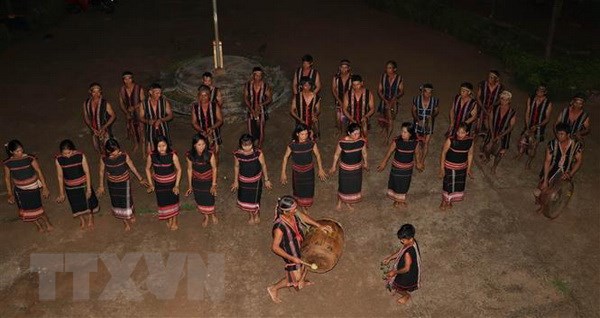
More than 1,000 artisans from five Central Highlands provinces will perform at the 2018 Gong Cultural Festival scheduled to take place from November 30 to December 2 in Gia Lai province.
Illustrative photo (Photo:
VNA)
The event will feature many traditional
festivals and rituals in the region, along with special regional dishes.
During the festival, visitors can engage in community-based tours to explore
daily life of local people and beautiful landscape in Gia Lai.
The festival is expected to welcome between 25,000 and 30,000 visitors along
with 300 invited guests from ministries, sectors and UNESCO Vietnam, foreign
embassies and consulate generals in Vietnam.
Nguyen Quang Tue, from the provincial Department of Culture, Sports and
Tourism, said more than half of over 10,000 sets of gongs in the Central
Highlands are now being preserved by Gia Lai province.
The Cultural Space of Gong of Tay Nguyen was recognised by the UNESCO as a
masterpiece of the oral and intangible heritage of the humanity in 2005. It is
closely linked to the daily life of local people. Their belief systems form a
mystical world where the gongs produce a privileged language between men,
divinities and the supernatural world.
The Central Highlands region comprises five provinces of Lam Dong, Gia Lai, Dak
Lak, Dak Nong and Kon Tum.
Source: VNA
With an increasingly vibrant and widespread emulation movement aimed at building cultured residential areas and cultured families, Yen Thuy District has been making steady progress toward improving both the material and spiritual well-being of its people, while fostering a civilized, prosperous, beautiful, and progressive community.
Once lacking recreational spaces and community facilities, Residential Group 2 in Quynh Lam Ward (Hoa Binh City) has recently received attention for the construction of a new, spacious, and fully equipped cultural house. The project followed the model of state support combined with public contributions in both labor and funding.
The "All people unite to build cultural life" movement, which has been effectively integrated with Kim Boi district’s socio-economic development goals, is fostering a lively spirit of emulation across local residential areas, hamlets, villages, public agencies, and enterprises. In addition, through the initiative, traditional cultural values are being preserved and promoted, while community solidarity and mutual support in poverty reduction and economic development are being strengthened.
A working delegation of the Hoa Binh provincial People’s Committee led by its Permanent Vice Chairman Nguyen Van Toan on June 11 inspected the progress of a project to build the Mo Muong Cultural Heritage Conservation Space linked to tourism services in Hop Phong commune, Cao Phong district.
Born and growing in the heroic land of Muong Dong, Dinh Thi Kieu Dung, a resident in Bo town of Kim Boi district, in her childhood was nurtured by the sweet lullabies of her grandmother and mother. These melodies deeply imprinted on her soul, becoming an inseparable part of her love for her ethnic group's culture. For over 20 years, this love for her hometown has driven Dung to research, collect, and pass down the cultural values of the Muong people to future generations.
In the final days of May, the Ethnic Art Troupe of Hoa Binh Province organized performances to serve the people in remote, mountainous, and particularly disadvantaged areas within the province. These were not just ordinary artistic shows, but they were the meaningful journeys aimed at spreading cultural values, enhancing the spiritual life of the people and contributing to the preservation of ethnic minority cultural identities.



